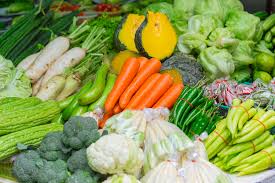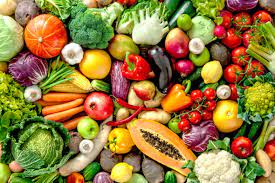Pesticide residue refers to the pesticides or metabolic products of the pesticides that may remain in food grains, vegetables and fruits after they are applied to crops.
Many of these chemical residues, especially derivatives of chlorinated pesticides, exhibit bioaccumulation, which could build up to harmful levels in the body as well as in the environment (Sachs etal., 2010).
Persistent chemicals can be magnified through the food chain and have been detected in products ranging from meat, poultry, and fish, to vegetable oils, nuts, and various fruits and vegetables (Crinnion, 2009). Insects and pests can cause a loss in the quality and quantity of grains and their products.
Pesticide Residues in Fruits and Vegetables
The most consumed pesticides for vegetables and fruits include sulphur, endosulfan, mancozeb, phorate, methyl parathion, monocrotophos, cypermethrin, isoproturon, chlorpyrifos, malathion, carbendazim, butachlor, quinalphos, copper oxychloride, and dichlorvos.
The use of pesticides during production often leads to the presence of pesticide residues in fruits and vegetables after harvest.
Most farmers and commercial producers treat vegetables and fruit with pesticides on several occasions during growing because pesticides decrease toxins produced by food infecting organisms, increase productivity and are less labor intensive.
Pesticide Residues in Vegetables
According to a study, the cucumber was the crop with the highest number of pesticide residues with the predominant presence of methomyl, metalaxyl, and imidacloprid. Methomyl is a carbamate insecticide with restricted use because of its high toxicity to humans.
The other pesticide residues found in cucumber samples were boscalid, chlorpyrifos, cyprodinil, fenhexamid, imidacloprid, metalaxyl and tebuconazole (Kostiket al., 2014).

The commodities with the highest level of pesticide residues found in China were cabbage, legumes and leaf mustard (Chemet al., 2011).
High level of pesticide residues was also determined in imported bitter melon, peas, beans, eggplant, spinach and other vegetables.
A study on analysis of pesticide residue concentration in vegetables revealed that the risk to consumers varies with the season and it was reported that the winter season has the highest pesticide concentration in vegetables (Bhanti, and Taneja, 2007).
Pesticide Residues in Fruits
Study revealed that many fruits contained more than one residue per product, up to 9 residues in grapes and tea were determined, up to 5 – 9 residues in citrus fruits like orange, mandarins, lemons, peaches, pears and up 3 – 5 residues in pomegranates, plums, cucumbers, tomatoes, strawberries.
The most frequently detected pesticide residues were imazalil, thiabendazole, chlorpyrifos, maneb group, procymidone, methidathion, lambda-cyhalothrin, carbendazim, iprodione, orthophenylphenol, vinclozolin, endosulfan, pyrimethanil, fenhexamid, prochloraz, cyprodinil, boscalid.
Apples, papayas, sweet peppers and strawberries were among products with the highest percentage of samples with residues above the maximum residue limit found in the Brazilian pesticide residues monitoring program.
High level of pesticide residues in pears, grapes, citrus fruit, peppers, cucumbers, tomatoes, carrots were obtained in Lithuania (Petraitiset al., 2013). A study in Belgium revealed that pesticide residues were detected in 72% of the samples and standards were exceeded for 6% of the samples.
Imported blackberries, strawberries and other berries as well as mangoes, papaya and pepinos also contained high levels of pesticide residues. The insecticide residues reported in market samples of grapes were acephate, methamidophos, chlorpyriphos, monocrotophos and quinalphos.
Pesticide Residues in Processed Fruits and Vegetables
A study on the levels of pesticides in soft drinks available in Indian market indicates pesticide residues 24 times higher than Bureau of Indian Standards (BIS) norms. The levels of pesticide residue in lindane exceeded the BIS standards by 140 times in some samples.
Heptachlor, which was banned in India, was found in 71 per cent of the samples, at levels four times higher than BIS standards. Chlorpyrifoswas found 200 times more than the BIS standard in a sample manufactured in Thane.
The average amount of pesticide residues found in all the samples was 24 times higher than the BIS standards for total pesticides in soft drinks (Source: The Hindu).
Organochlorine pesticides, mainly isomers of hexachlorohexane, dichloro-diphenyl-trichloroethane, endosulphan, endrin, aldrin, dieldrin, and heptachlore, were identified from potable water samples collected from all over India (Agarwal et al., 2015).
The residues of lambda-cyhalothrin in acid lime were persisted for 20 days and in juice samples maximum residues were observed for 10 days.
Read Also : Heavy Metal Contamination in Soil
In conclusion, the excess consumption of pesticides contributes in the accumulation of pesticide residues in food grains and vegetables associated with variety of human health hazards, including damage to central and peripheral nervous systems, cancer, allergies and hypersensitivities, reproductive disorders, and disruption of the immune system.
The impact of pesticide residues can be minimized by preventive measures such as rational use of pesticides, washing and proper processing of food products, practicing organic farming, use of natural pesticides and bio-pesticides, and strict implementation and amendment of pesticide-related laws.
Pesticide residues get into fruits and vegetables either through direct pesticide application to control pest and diseases on the field;
The extent of pesticide residues problems is aggravated by the fact that many fruit and vegetables are consumed directly with little or no processing.
Associated pesticide residues vary from crop to crop depending on the type of pesticide sprayed to enhance their quality.
Preventive measures in place to prevent health problems associated with pesticide residues in food includes organic farming, washing food products, processing food products, rational use of pesticides, use of natural pesticides and bio-pesticides, etc.

